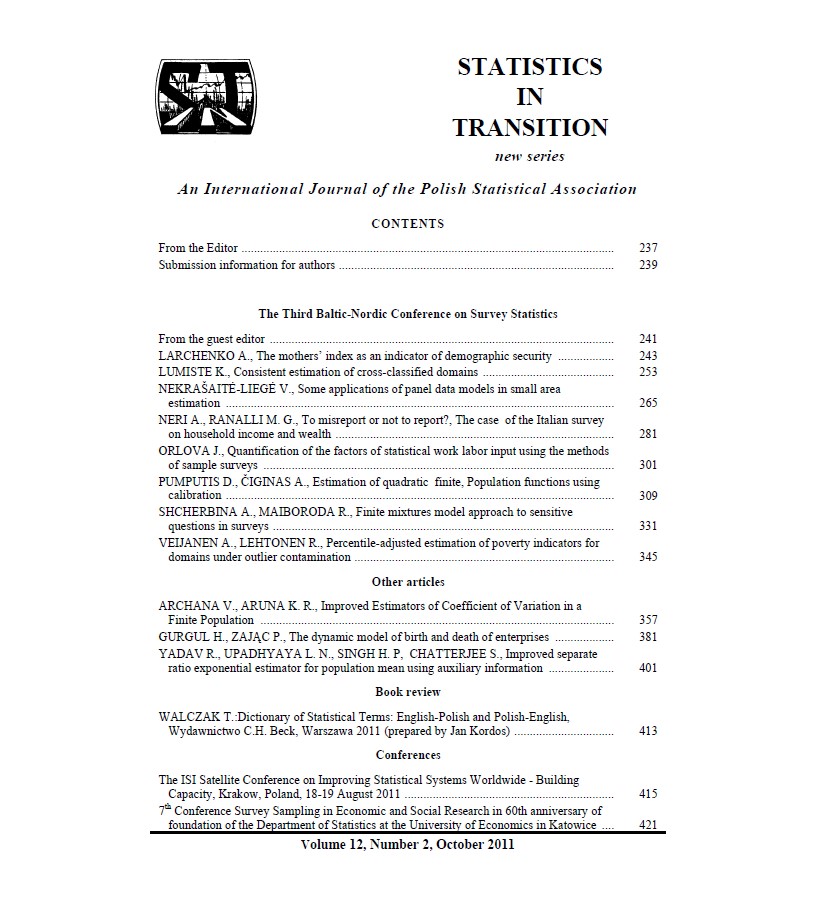ARTICLE
ABSTRACT
The objective of the paper is to adjust for the bias due to unit nonresponse and measurement error in survey estimates of total household financial wealth. Sample surveys are a useful source of information on household wealth. Yet, survey estimates are affected by nonsampling errors. In particular, when it comes to household wealth, unit nonresponse and measurement error can severely bias the estimates. Using the Italian Survey on Household Income and Wealth, we exploit the available auxiliary information in order to assess the magnitude of such a bias. We find evidence that for this kind of surveys, nonsampling errors are a major issue to deal with, possibly more serious than sampling errors. Moreover, in the case of SHIW the potential bias due to measurement error seems to outweigh by far that induced by nonresponse.
KEYWORDS
Unit Nonresponse; Measurement Error; Auxiliary Information; Subsampling; Imputation.
REFERENCES
Bagozzi, R. (1994). Measuring in market research: basic principal of questionnaire design. Principles of Marketing Research in: Blackwell Business.
Biancotti, C., G. D’Alessio, and A. Neri (2008). Measurement error in the Bank of Italy’s survey of household income and wealth. Review of Income and Wealth, 54-3.
Biemer, P. (2010). Total survey error: design, implementation, and evaluation. Public Opinion Quarterly 74, 817-848.
D’Alessio, G. and I. Faiella (2002). Nonresponse behaviour in the Bank of Italy’s survey of household income and wealth. Temi di Discussione del Servizio Studi, Banca d’Italia 462.
Durrant, G. B. and C. Skinner (2006). Using missing data methods to correct for measurement error in a distribution function. Survey Methodology, 32-1, 25-36.
Ekholm, A. and S. Laaksonen (1991). Weighting via response modeling in the Finnish Household Budget Survey. Journal of Official Statistics 7, 325-337.
European Central Bank (2009). Survey data on household finance and consumption. ECB, Occasional paper series (100).
Folsom, R. E. (1991). Exponential and logistic weight adjustments for sampling and nonresponse error reduction. In ASA Proceedings of the Social Statistics Section, pp. 197-202.
Fuller, W. A., M. M. Loughin, and H. D. Baker (1994). Regression weighting in the presence of nonresponse with application to the 1987-1988 Nationwide Food Consumption Survey. Survey Methodology 20, 75-85.
Kim, J. K. and J. J. Kim (2007). Nonresponse weighting adjustment using estimated response probability. The Canadian Journal of Statistics 35 (4), 501-514.
Kott, P. S. (2006). Using calibration weighting to adjust for nonresponse and coverage errors. Survey Methodology 32 (2), 133-142.
Laaksonen S. and R. Chambers (2006) Survey estimation under informative nonresponse with follow-up, Journal of Official Statistics 22, 81-95
Lessler, J. T. and W. D. Kalsbeek (1992). Nonsampling Error in Surveys. John Wiley & Sons.
Little, R. J. A. (1986). Survey nonresponse adjustments for estimates of means. International Statistical Review 54, 139-157.
Moore, J., L. Stinson, and E. Welniak (2000). Income measurement error in surveys: A review. Journal of Official Statistics 16, 331-361.
Ruppert, D., M. P.Wand, and R. Carroll (2003). Semiparametric Regression. Cambridge University Press, Cambridge, New York.
Särndal, C.-E., B. Swensson, and J. Wretman (1992). Model Assisted Survey Sampling. Springer, Berlin, New York.
Wu, C. and Y. Luan (2003). Optimal calibration estimators under two-phase sampling. Journal of Official Statistics 19, 119-131.
